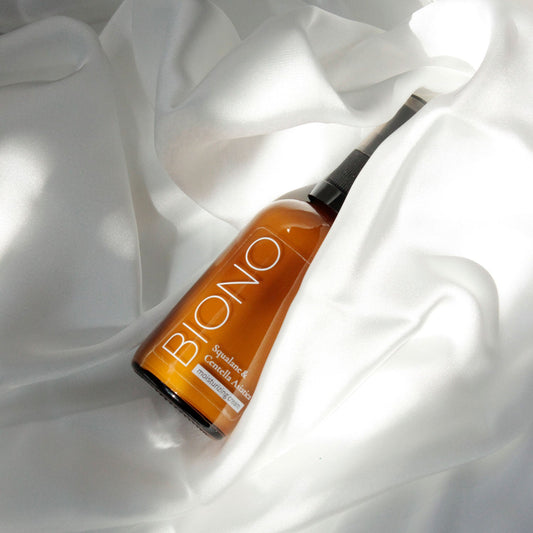
Anti-aging care with niacinamide, retinol and salicylic acid: how to combine correctly
Anti-aging skin care is not just a fashion statement, but a necessity for maintaining youthfulness and health of the epidermis. Modern cosmetology offers a variety of active ingredients, among which niacinamide, retinol and salicylic acid occupy a special place. Each of these components has unique properties and can significantly improve the condition of the skin, but it is important to understand how to use them correctly and combine them with each other to achieve maximum effect without irritation.
What is anti-aging care and when to start it
Anti-aging care is a comprehensive approach to preserving youthful skin, which includes the use of special cosmetics with active ingredients. Unlike basic moisturizing and cleansing, anti-aging products are aimed at combating specific problems: wrinkles, pigmentation, loss of elasticity and dull complexion. Modern dermatologists recommend starting preventive anti-aging care from the age of 25, when the process of cell renewal begins to slow down.
Key ingredients like niacinamide, retinol, and salicylic acid work at different levels of the skin and address a variety of issues. Niacinamide strengthens the skin barrier and evens out skin tone, retinol stimulates cell turnover and collagen synthesis, and salicylic acid unclogs pores and exfoliates dead skin cells. Understanding how each ingredient works will help you build an effective skincare regimen tailored to your skin's individual needs.

Niacinamide in anti-aging care: a universal helper
Niacinamide, also known as vitamin B3, is deservedly considered one of the most versatile ingredients in cosmetology. This component is suitable for absolutely all skin types, rarely causes irritation and combines perfectly with most active ingredients. Niacinamide works on the surface of the epidermis, strengthening the lipid barrier that protects the skin from moisture loss and external aggressors.
In the context of anti-aging care, niacinamide shows impressive results. It reduces the appearance of fine lines, evens out skin tone, lightens age spots, and tightens enlarged pores. Regular use of niacinamide products helps improve skin texture, making it smoother and more radiant. This ingredient is especially effective for those with combination skin types that show signs of photoaging.
The optimal concentration of niacinamide in cosmetics is from 2% to 10%. For daily care, a 5% concentration is sufficient, which will provide visible results without the risk of irritation. Niacinamide can be used both morning and evening, it does not increase the photosensitivity of the skin, therefore it does not require the mandatory use of SPF, although sun protection always remains an important part of anti-aging care regardless of the active ingredients used.
Retinol in anti-aging care: the gold standard of rejuvenation
Retinol is rightly called the gold standard of anti-aging care due to its scientifically proven effectiveness. This derivative of vitamin A penetrates the deep layers of the epidermis, where it stimulates collagen production and accelerates cell renewal. It is retinol that is able not only to prevent the appearance of new wrinkles, but also to reduce existing ones, making the skin smoother and more elastic.
The mechanism of action of retinol is to accelerate cell turnover and stimulate fibroblasts - cells responsible for the synthesis of collagen and elastin. In addition, retinol normalizes the work of the sebaceous glands, which makes it effective not only against wrinkles, but also for combating acne and post-acne. Regular use of retinol evens out the skin's texture, lightens pigmentation and returns a healthy color to the face.
However, anti-aging care with retinol requires the right approach and gradualness. Beginners should start with low concentrations (0.25-0.3%) and use the product 2-3 times a week. Gradually, when the skin adapts, you can increase the frequency of use and concentration to 0.5-1%. It is important to remember that retinol makes the skin more sensitive to the sun, so it is used exclusively in the evening and be sure to apply SPF in the morning.
Salicylic acid and anti-aging care: an unexpected combination
Salicylic acid is traditionally associated with problem skin care, but its role in anti-aging care is often underestimated. This lipophilic ingredient is able to penetrate sebum-filled pores and dissolve comedones from the inside. In addition to its cleansing effect, salicylic acid has anti-inflammatory properties and gently exfoliates dead skin cells, improving skin texture.
In the context of anti-aging care, salicylic acid is particularly useful for mature, oily and combination skin. It helps combat enlarged pores, which become more noticeable with age due to the loss of skin elasticity. Regular use of salicylic acid improves the penetration of other active ingredients, making the skin smoother and more prepared for the application of other care products.
The optimal concentration of salicylic acid for daily care is 0.5-2%. Higher concentrations are usually used in professional peels. For anti-aging care, it is enough to use a toner or serum with salicylic acid several times a week, especially if you use other active ingredients in parallel. Salicylic acid can dry the skin, so it is imperative to apply moisturizer after it.
How to combine niacinamide with other active ingredients
One of the biggest advantages of niacinamide is its excellent compatibility with almost all active ingredients. Unlike other powerful ingredients, niacinamide rarely causes conflicts and can be used in the same routine with retinol, salicylic acid, vitamin C and peptides. What’s more, niacinamide often enhances the effects of other actives while reducing the risk of irritation.
The combination of niacinamide and retinol is considered one of the most effective in anti-aging care. Niacinamide strengthens the skin's protective barrier, which helps to better tolerate the potentially irritating effects of retinol. The optimal scheme of use: in the evening, first apply the serum with niacinamide, wait 10-15 minutes for complete absorption, and then apply retinol. This will allow you to get the maximum benefit from both ingredients with minimal risk of side effects.
Niacinamide and salicylic acid also work well together, especially for oily and combination skin. Salicylic acid unclogs pores and exfoliates, while niacinamide regulates sebum production and strengthens the skin barrier. Use a salicylic acid toner after cleansing, and apply a niacinamide serum a few minutes later. This combination is especially effective for preventing and correcting age-related changes in people prone to oily shine and enlarged pores.
Rules for using retinol in anti-aging care
Retinol is a powerful ingredient that requires a responsible approach and understanding of the rules of use. The first and most important rule is to always apply retinol only at night to cleansed, dry skin. Even a drop of moisture can increase the penetration of retinol and cause irritation. Wait 20-30 minutes after washing before applying a retinol product to allow the skin to dry completely.
Starting to use retinol should always be gradual. Here is a recommended introduction schedule:
- First month — use retinol once a week to let your skin adapt
- Second month - increase frequency to twice a week, observing skin reaction
- Third month - switch to using every other day if the skin tolerates the previous stage well
- Fourth month and beyond — you can use retinol every evening if there is no irritation
- If dryness or peeling occurs, take a break for a few days and return to the previous stage.
- Always combine retinol with a quality moisturizer 30 minutes after application
It is important to understand that the first results from using retinol appear only after 8-12 weeks of regular use. Do not expect an instant effect and do not increase the dosage in the hope of speeding up the process. Patience and consistency are the keys to successful anti-aging care with retinol. If you are planning a pregnancy, are already pregnant or breastfeeding, you should refrain from using retinol and consult your doctor about safe alternatives.
Salicylic acid: nuances of use for mature skin
Although salicylic acid is most often associated with teenage acne, it can be a valuable anti-aging ingredient for certain skin types. For mature skin, it's best to choose milder concentrations (0.5-1%) and use them 2-3 times a week rather than daily. This will provide an exfoliating effect without over-drying, which is especially undesirable for skin with signs of aging.
The best time to use salicylic acid is in the evening, after cleansing and before applying other active ingredients. If you use retinol, it is a good idea to split them up into different evenings: for example, salicylic acid on Monday and Thursday, retinol on Wednesday and Saturday. This will ensure effective skin renewal without the risk of over-irritation from multiple strong ingredients at once.
For mature skin, intensive hydration is especially important after using salicylic acid. Choose creams with ceramides, hyaluronic acid, and peptides that will restore the lipid barrier and compensate for potential dryness. If you feel tightness or peeling, reduce the frequency of using salicylic acid or temporarily abandon it completely, focusing on restoring and moisturizing the skin.

Building an effective anti-aging routine
Creating an effective anti-aging routine is an art of balancing the right amount of active ingredients and avoiding overloading your skin. The main rule is not to try to use all the powerful ingredients at once. It is better to introduce new actives gradually, one at a time, giving your skin 4-6 weeks to adapt before adding the next ingredient.
Here is an example of a balanced anti-aging routine with all three ingredients:
- Morning: Cleanse, Toner with niacinamide 5%, Antioxidant Serum, Moisturizer, SPF 50
- Evening (Monday, Wednesday, Friday): cleansing, mild toner, serum with retinol 0.5%, nourishing cream with ceramides
- Evening (Tuesday, Thursday): Cleanse, 1% salicylic acid toner, niacinamide serum, moisturizer
- Evening (Saturday, Sunday): cleansing, soothing toner, intensive moisturizing mask or serum with hyaluronic acid, nourishing cream
This regimen ensures regular use of all key anti-aging ingredients, while giving your skin enough time to recover. Weekends are dedicated to hydration and recovery, which helps prepare your skin for a new week of active exposure. Remember that this is only an approximate regimen - adjust it to your needs, skin characteristics and individual tolerance of active ingredients.
Common mistakes in anti-aging care
Many people make similar mistakes when starting an anti-aging regimen, which can reduce the effectiveness of the products or even harm the skin. The most common mistake is overusing active ingredients in the hope of getting faster results. Using retinol every night from day one, mixing multiple acids in one routine, or using too high concentrations inevitably leads to irritation, dryness, and disruption of the skin's protective barrier.
The second common mistake is ignoring hydration and repair. Focusing on powerful actives, many forget that a healthy lipid barrier is the foundation of youthful skin. Even if you use the most effective retinol or the highest quality niacinamide, without proper hydration and protection, the results will be much more modest. Be sure to include products with ceramides, peptides, and fatty acids in your routine, especially if you use active ingredients.
The third mistake is a lack of patience and constant change of products. Anti-aging care takes time to show visible results - usually 2-3 months of regular use. If you change products every few weeks without seeing an immediate effect, you will never be able to assess the true effectiveness of the ingredients. Give your skin time to adapt and react to new assets before drawing conclusions about their effect.
When to expect results and how to evaluate them
Realistic expectations are an important part of successful anti-aging care. Different ingredients work at different speeds and show first results in different periods. Niacinamide is one of the fastest active ingredients, the first changes can be noticed after 2-4 weeks of regular use. The skin becomes more even in tone, oily sheen is reduced, fine wrinkles become less noticeable.
Retinol requires more patience - real results appear after 8-12 weeks, and the maximum effect is achieved after 6-12 months of constant use. At first, it may seem that nothing is happening, or you may even see a temporary deterioration in your skin condition (adaptation period). This is normal - retinol accelerates cell renewal, which may cause short-term peeling. Continue using it, and the results will definitely appear.
Salicylic acid in anti-aging care shows results quite quickly - skin texture improves after 1-2 weeks, pores become less noticeable. To assess progress, it is useful to take photos of your face in the same lighting every 4 weeks. Pay attention not only to wrinkles, but also to the general condition of the skin: its tone, texture, pore size, the presence of pigmentation. Often, the most significant changes are noticed by others, not by ourselves, since we see our face every day.
Conclusions: building a personal anti-aging care strategy
Effective anti-aging isn’t about using every ingredient possible at once, but about smartly combining proven actives according to your skin’s needs. Niacinamide, retinol, and salicylic acid are a powerful trio that can significantly improve the condition of mature skin, but only if used correctly. Start with one ingredient, gradually add others, listen to your skin, and don’t be afraid to adapt your routine to its needs.
Remember, anti-aging is a marathon, not a sprint. Results come gradually, but they are sustainable and cumulative. Invest in quality products with proven effectiveness, be consistent in application, and be sure to protect your skin from the sun every day. It is a comprehensive approach that includes cleansing, active ingredients, moisturizing, and SPF that will ensure your skin looks young and healthy for years to come.


